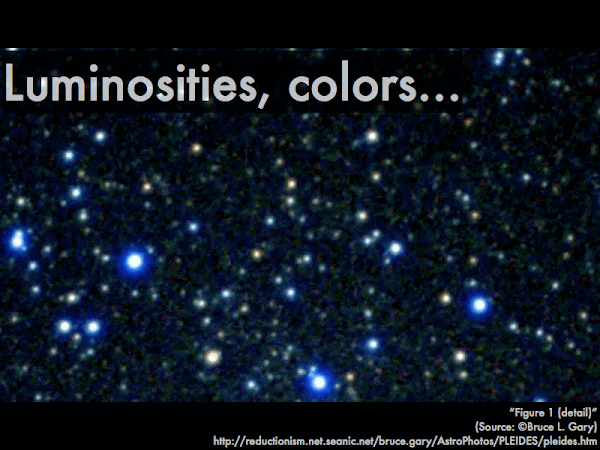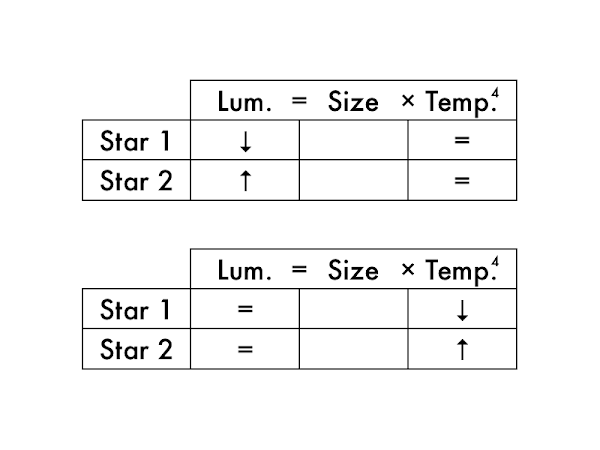Cuesta College, San Luis Obispo, CA
Students have a weekly online reading assignment (hosted by SurveyMonkey.com), where they answer questions based on reading their textbook, material covered in previous lectures, opinion questions, and/or asking (anonymous) questions or making (anonymous) comments. Full credit is given for completing the online reading assignment before next week's lecture, regardless if whether their answers are correct/incorrect. Selected results/questions/comments are addressed by the instructor at the start of the following lecture.
The following questions were asked on reading textbook chapters and previewing presentations on parallax, distance, apparent magnitude, absolute magnitude, Wien's law and the Stefan-Boltzmann law, and a TED-Ed talk on stellar properties.

Selected/edited responses are given below.
Describe something you found interesting from the assigned textbook reading or presentation preview, and explain why this was personally interesting for you.
"How the brightness of stars can change based on distance, you'd think that with space being a giant vacuum, that the light wouldn't really dim."
The stars we see might not be as bright/dim as they actually are."
"In the textbook, it just said astronomers measure stars from two different viewpoints. I like how you specified that 'two different viewpoints for looking at a star is from Earth when it is at one end of its orbit, then six months later from Earth when it is at the other end of its orbit.' I thought that was helpful and interesting."
"The video on how we study the stars based on light and wavelengths was cool."
"The YouTube video on how we can determine the age, distance, and mass of a star by looking at its brightness."
"White stars are hotter than red ones; because I thought red stars are the hottest."
"That the hottest stars are white or blue, and the red stars are the coolest. You would think that red means hotter!"
"How bigger stars aren't always the hottest and sometimes smaller ones can be hotter. Also, how the color of the star shows the temperature of it (but still don't understand how)."
"That a parsec is 3.26 light years. This was interesting because they say parsecs in movies and shows and I never really knew how much distance it was."
Describe something you found confusing from the assigned textbook reading or presentation preview, and explain why this was personally confusing for you.
"I found the arcseconds difficult, along with the earths parallax when figuring out how far away stars are. The fact that is slightly shifts means there further or closer confuses me, which is which."
"Calculating the difference of luminosity using the absolute magnitude scale."
"The brightness scale is confusing for me all around. I feel like I can remember it but I don't quite understand it."
"Apparent and absolute magnitudes were really confusing and hard to understand because none of the questions were making sense on this assignment."
"Distance and brightness."
"The spectra graphs were extremely confusing to look at and read, the descriptions underneath help with deciphering what is where but it is still confusing for me it seems busy and it makes my brain shut down."
"I don't understand the luminosity = size × temperature formula or how to tell which star is larger when they are the same distance away. I need some more explanations and clarifications of this."
"The Stefan-Boltzamann law was a little confusing to me and I could use a little more detailed and broken down explanation of it. Also, how we measure the distance of stars is a little confusing. Also, all this astronomy math going on? Helpppppppppp."
"Wien's law and the Stefan-Boltzmann Law, and I also found how we determine the distances of the star to be confusing."
"Teh only confusing law is 'since both stars have the same color [but one is bigger than the other], from Wien's law, they must have the same temperature.'"
Explain how apparent magnitude and the absolute magnitude are defined differently.
"Apparent magnitude is how bright we think a star is, and absolute magnitude is how bright the star actually is."
"Absolute magnitude is the apparent visual magnitude that star would have if it were 10 pc away. Apparent magnitude is how stars look to human eyes observing from Earth."
"Apparent magnitude measures how bright it is to you on earth while absolute magnitude is an idea that if you line up all the stars at the same distance away from you, you'd be able to tell which are the brightest."
"Apparent magnitude is the brightness from Earth. Absolute magnitude is when you use the 'fair comparison distance' by putting both stars 10 parsecs away and then measuring the correct brightness."
Suppose the sun was moved to a distance of 10 parsecs away. As a result, its __________ magnitude would become dimmer.
absolute. ******* [7] apparent. ************ [12] (Both of the above choices.) [0] (Neither of the above choices.) [0] (Unsure/guessing/lost/help!) [0]

(Only correct responses shown.)
1 (brightest): the sun, m = –27 [100%]
2: Canopus, m = –1 [89%]
3: Vega, m = 0 [95%]
4 (dimmest): Kapteyn's star, m = +9 [95%]
Rank the brightnesses of these stars (1 = brightest, 4 = dimmest; there are no ties), if relocated to 10 parsecs from Earth.
(Only correct responses shown.)
1 (brightest): Canopus, M = –3 [79%]
2: Vega, M = +0.5 [84%]
3: the sun, M = +5 [84%]
4 (dimmest): Kapteyn's star, M = +11 [84%]
Determine whether these stars get dimmer or brighter when relocated from their original positions to 10 parsecs from Earth.
(Only correct responses shown.)
The sun: gets dimmer [84%]
Canopus: gets brighter [74%]
Vega: gets dimmer [42%]
Kapteyn's star: gets dimmer [68%]
Rank the temperatures of these main sequence stars (1 = hottest, 4 = coolest; there are no ties).
(Only correct responses shown.)
Hottest: blue main sequence star [74%]
Second hottest: white main sequence star [74%]
Third hottest: yellow main sequence star [74%]
Coolest: red main sequence star [84%]
Rank the temperatures of these supergiant and dwarf stars (1 = hottest, 4 = coolest; there are no ties).
(Only correct responses shown.)
Hottest: blue supergiant [68%]
Second hottest: white dwarf [94%]
Third hottest: yellow supergiant [74%]
Coolest: red dwarf [84%]

dimmer. **** [4] brighter. ************* [13] (These stars would be the same size.) [0] (Unsure/guessing/lost/help!) ** [2]
Two stars (equally far away) have the same brightness, but one star is cooler, and the other star is hotter. The __________ star will be larger in size.
cooler. ********** [10] hotter. ***** [5] (These stars would be the same size.) ** [2] (Unsure/guessing/lost/help!) ** [2]
Ask the instructor an anonymous question, or make a comment. Selected questions/comments may be discussed in class.
"This material has me nervous. I'm hoping lecture clears it up a bit."
"Need to go over the two laws in more detail, Wien's law and the Stefan-Boltzmann law."
"Can we go over the temperature of the stars a little more?"
"Can we go over the luminosity-size-temperature charts?"
"Do we have one reading assignment per week, or two? Because I am still confused." (There is only one reading assignment per week. However, on each week's announcements page, at the top is the link to the reading assignment that is to be done before that week's class. At the bottom is the link to the reading assignment to be done over the weekend, before next week's class.)
"How would we know for sure how hot the stars are? Also, why are our quiz questions each worth 4.0 points. It kills me!" (The color of a star tells us its temperature. But is 4.0 points per quiz question too many points, or too few?)
"Are we going to have to memorize the word formulas?" (Yes, but more importantly you should memorize how to logically think through applying those formulas, similar to how you needed to logically work your way through moon phases and times. I'll help you get there.)
No comments:
Post a Comment